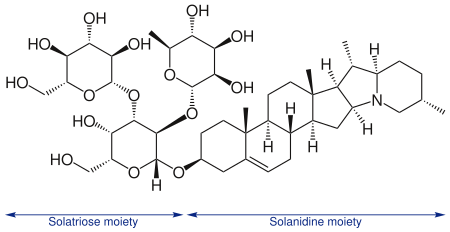Glycoalkaloid

Glycoalkaloids are a family of chemical compounds derived from alkaloids to which sugar groups are appended. Several are potentially toxic, most notably the poisons commonly found in the plant species Solanum dulcamara (bittersweet nightshade) and other plants in the genus Solanum, including potato.
A prototypical glycoalkaloid is
gastrointestinal tract
, therefore causing gastrointestinal irritation. The aglycone is absorbed and is believed to be responsible for observed nervous system signs.
Taste
Glycoalkaloids are typically
cultigens.[1]
Detection
Although not routinely available, detection of alkaloids in tissues or urine is possible for laboratory diagnosis of exposure.[2]
Treatment
Sale of a glycoalkaloid-based treatment marketed by Lane Labs USA Inc. for prevention of skin cancer was banned by the FDA in 2004 as an unapproved drug.[3]
References
- S2CID 36486230.)
{{cite journal}}: CS1 maint: multiple names: authors list (link - ^ ""Poisonous Plants Slides - European Bittersweet, Climbing Nightshade"". cal.vet.upenn.edu. Archived from the original on June 16, 2007.
- ^ fda.gov, news item 1086 Archived October 7, 2006, at the Wayback Machine
External links
 Media related to Glycoalkaloid at Wikimedia Commons
Media related to Glycoalkaloid at Wikimedia Commons
